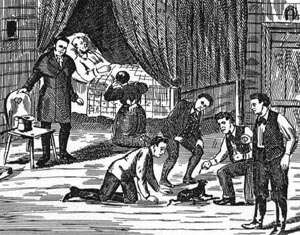What Happened to The Tomb of Alexander the Great?
It is 323 BCE, and Alexander the Great of Macedon is 32 years old and at the pinnacle of his power. He becomes ill after a bout of heavy celebratory drinking while resting in Nebuchadnezzar II’s palace in Babylon.
Alexander dies after 11 to 12 days of undiagnosed illness and loss of consciousness. So, what happened to the tomb of Alexander the Great?
Alexander’s remains were not permitted to rest. After encasing Alexander’s body in a gold tomb and coffin, his generals and allies prepared a massive procession to return Alexander’s body to Macedon to be buried.
But they were attacked by one of their own, Ptolemy, a general in Alexander’s army who would dominate Egypt as Ptolemy I Soter.

The Story Behind Alexander the Great’s Death
He had conquered an empire ranging from the Balkans to modern Pakistan at the age of 32 and was on the verge of another invasion when he fell ill and died after 12 days of terrible pain. Historians have discussed his death since then, with theories ranging from malaria, typhoid, and alcohol poisoning to assassination by one of his competitors.
According to one view, Alexander died due to the neurological condition Guillain-Barré Syndrome, according to a scholar and practicing clinician. She further claims that others may not have detected any apparent symptoms of decomposition on Alexander’s body because he wasn’t quite dead.

When Alexander’s symptoms were submitted to the Global Infectious Disease Epidemiology Network’s databases, influenza ranked first on the list of possible diagnoses. On the other hand, they believe that the symptoms and progress of Alexander’s condition are inconsistent with influenza, malaria, schistosomiasis, and poisoning.
Another idea, which deviates from sickness, proposes that a congenital scoliotic condition caused Alexander’s death. Alexander was thought to have structural neck abnormalities and oculomotor impairments, which could be related to Klippel-Feil syndrome, a rare congenital scoliotic condition.
Experts assume this because of his physical defects and symptoms preceding his death. Some believe that as Alexander deteriorated in his final days, he developed progressive epidural spinal cord compression, rendering him paralyzed. This theory, however, cannot be proved without a thorough examination of Alexander’s body.
The Ambush and The Burial
Alexander’s request to be buried at Siwa was denied. The burial cart carrying Alexander’s body was seized in Syria in 321 BC by one of Alexander’s generals, Ptolemy I Soter, on its route back to Macedonia.
Ptolemy moved the body to Egypt in late 322 or early 321 BC, where it was buried in Memphis, the seat of Alexander’s government in Egypt. While Ptolemy held Alexander’s body, Perdiccas and Eumenes possessed Alexander’s armor, wreath, and imperial scepter.
According to Plutarch, when he visited Alexandria, the Python of Catana and Seleucus were dispatched to a serapeum to ask the oracle if Alexander’s body should be delivered to Alexandria, to which the oracle replied positively.

Alexander’s body was relocated from the Memphis tomb to Alexandria for reburial in the late 4th or early 3rd century B.C.
Ptolemy Philopator afterward interred Alexander’s body in Alexandria’s municipal mausoleum. The Soma or Sema tomb was named after the Greek word for “body,” Soma.
Alexander was already buried at Alexandria by 274 BC. The Tomb of Alexander became the main discussion point of Alexander the Great’s Ptolemaic religion.
Famous Visitors Who Went to The Tomb of Alexander the Great
Julius Caesar paid his homage at the tomb of Alexander the Great in 48 B.C. and sobbed when overpowered by emotion. However, other Nobel visitors to the tomb were not as courteous as Caesar. Cleopatra was claimed to have taken gold from the tomb to use as financial fuel in her war with Octavian.
Following Cleopatra’s death, Octavian visited the tomb and placed flowers and a gold diadem on it. According to the Roman writer Seutonius, Caligula seized Alexander’s armor.
Septimius Severus paid his respects to Alexander’s final resting place, and had it walled up in 199 A.D. Sixteen years later, Alexander’s son, Caracalla, removed his father’s ring, tunic, and ring and repositioned them on the coffin.

Two centuries later, John Chrysostom, the Archbishop of Constantinople, traveled to Alexandria and begged to be taken to the tomb of Alexander the Great. He was disappointed to find out that no one knew where the tomb was. Meanwhile, the author Leo Africanus recounted seeing a small structure that appeared to be a chapel when visiting the remains of Alexandria.
According to the Mahometans, inside this church was a deeply respected tomb belonging to Alexander the Great. Africanus said that people from all over the world come to this tomb to honor it and worship the body that lies within.
Conflicting versions obscure the later history of the tomb of Alexander the Great. Some historians claim to have visited the tomb during the 15th and 17th centuries, including Ibn Abdel-Hakam, Al-Masoudi, and Leo Africanus.
Attempts to Locate The Tomb of Alexander the Great
Osman Hamdi Bey, director of the Ottoman Imperial Museum in Istanbul, reported a significant find at Sidon, Lebanon, in 1887. Two sets of underground chambers have been found and explored.
There are numerous sarcophagi. One of these is a stunning tomb carved from Greek Pentelian marble (similar to that used on the Acropolis), surrounded by some of the best classical Greek sculptures ever uncovered.
Liana Souvaltzi, a Greek archaeologist, declared in 1995 that she had identified one supposed tomb in Siwa as Alexander’s. The assertion was called into question by George Thomas, the then-general secretary of the Greek Ministry of Culture. She stated that it was questionable whether the unearthed structure was really a tomb.

Souvaltzi believed the tomb of Alexander the great demand to be buried at the temple of the Egyptian god Amun Ran had been granted; therefore, she applied for permission to explore the Oasis of Siwa in 1984. In 1989, Egyptian authorities gave her this request.
They discovered lion statues, an entranceway, and a Hellenistic royal tomb measuring 5,651 square feet. Souvaltzi thought Alexander’s famed colleague Ptolemy wrote the carvings and texts referring to body transfer.
Even though the ancient king’s tomb was finally rumored to be discovered in 1995, the Greek government called on Egypt’s government to halt excavations since tensions between the two were high. Souvaltzi is fighting to resume her dig, as Chugg’s latest discoveries are encouraging.
Dr. Andrew Chugg believes that the tomb of Nectaneb II in the British Museum in London offers true clues to the actual location of Alexander’s remains.
Regarding the tomb of Alexander the Great, Chug has a different theory. In his work, he explains that Pharaoh Nectaneb II built the initial temple of Alexander near Memphis in Egypt, in the Serapeum complex. New evidence appears to support this idea now, 16 years after the publication of his book.
A fragment of masonry discovered in the foundations of St. Mark’s Cathedral in Venice exactly fits the measurements of Nectaneb II’s coffin in the British Museum, suggesting that Alexander’s tomb is in Venice.
Chug claims that Venetian merchants stole Alexander’s body from Alexandria, who mistook it for St. Mark’s tomb when it vanished in 392. The body was then sent to Venice, where he has since been honored as Saint Mark in the cathedral.

Triantafyllos Papazois suggested in 1993 that Alexander the Great and his wife Roxanne are buried in royal tomb II at Vergina, Greece, while his son Alexander IV is buried in tomb III.
Based on ancient historical records, he concluded that the breastplate, shield, helmet, and sword discovered in tomb II belonged to Alexander the Great’s armor.
According to Thomas and his crew, the style of the discovered artifact was not Macedonian, as Souvaltzi claimed, and the shards of tablets they were given did not match any of the translations given by Souvaltzi as proof of her discovery.
Mohamed Omran, who is the director of Siwa’s Tourism Department, published evidence pointing to the possible finding of Alexander the Great’s tomb in the Marai area.
Omran stated that a temple was discovered in the area between 1995 and 1996, which historians considered could be congruent with the tomb of Alexander the Great. Omran also mentioned the finding of a temple dating back to the Greek and Roman eras three years ago.
It’s worth noting that Omran’s alleged evidence has yet to be validated. The tomb of Alexander the Great is marked as one of the holy grails of archeological discovery. It has been said to have been discovered multiple times in the past, with no results ever being substantiated.
The 2014 discovery of a massive Alexander-era tomb at Kasta Tomb in Amphipolis, Macedonia, Greece, fueled curiosity about Alexander’s ultimate resting place.
Some believe it was erected for Alexander but never utilized because Ptolemy I Soter seized the funeral procession. Based on the discoveries, the excavation team concluded that the tomb was a tribute to Alexander’s lover Hephaestion.
While there are few credible writings about Alexander’s life, historical chronicles offer us several stories about his last resting location. Alexander’s body was initially intended to be entombed in Macedonian but ended up in a gold coffin filled with honey in Memphis, Egypt.
His remains were then relocated to Alexandria, where they were housed in the city’s Soma, a walled royal zone that also housed the graves of Ptolemaic rulers. Worshippers must have sculpted a magnificent tomb into the rock beneath the Soma. It was there that his body was laid to rest.

Looting of Alexander, the Great’s Tomb
Some later Ptolemies are said to have looted the tomb for its treasures. Ptolemy X melted the golden coffin down and replaced it with a crystal or glass coffin. Cleopatra VII took gold from the grave to help finance her fight against Octavian, the Roman general who became Emperor Augustus.
Another Roman historian claimed that Caligula went to the tomb of Alexander the Great and stole his breastplate.
Why Is It Difficult to Find the Tomb?
Alexandria sinks into the Mediterranean Sea at a pace of 0.25 centimeters yearly. Perhaps due to this sinking, the tomb sunk deeper down and was quickly buried and then rebuilt to accommodate the city’s rising population.
Emperor Theodosius declared Christianity to be the only lawful religion in 391 CE. All paganism’s symbols were desecrated. Due to this, it is possible that a crowd of righteous and raging Christians, enraged by the devotion to Alexander’s tomb, demolished it in a fit of outrage.
This argument has precedent because Alexandria’s Serapis temple was demolished in 391 CE, most likely by a Christian mob.
Conclusion
In 356 AD, a tsunami swamped the city following a series of earthquakes that caused rising sea levels. Since Alexander’s time, the Nile Delta waters have caused Alexandria to sink up to twelve feet.
In essence, Alexander’s burial site and much of the ancient city on top of which the contemporary city is built must have fallen rather deeply below the bottom by now.
Archeologists have made more than 140 officially sanctioned attempts to locate Alexander the Great’s lost tomb. Each dig either yielded nothing or produced an unrelated discovery.
The site of the tomb of Alexander the Great, one of the most famous commanders of the ancient world and the founder of the Egyptian city of Alexandria, has long puzzled scholars worldwide.
Will it ever be possible to locate the tomb of Alexander the great? Are the tomb’s remains still in Egypt? The answer remains a mystery as of date.
References
https://www.britannica.com/biography/Alexander-the-Great
https://education.nationalgeographic.org/resource/alexander-great







